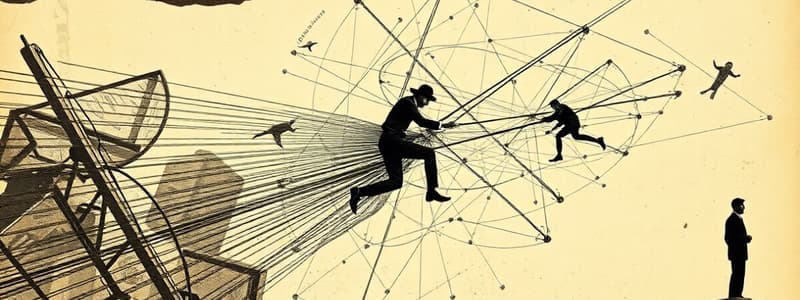Podcast
Questions and Answers
What does a free body diagram represent?
What does a free body diagram represent?
- The acceleration of an object due to gravity
- The velocity of an object over time
- All the forces acting on an object (correct)
- The energy transformations within an object
Which of the following scenarios exemplifies the application of Newton's laws of motion?
Which of the following scenarios exemplifies the application of Newton's laws of motion?
- A person sitting still in a chair
- A ball thrown in the air and its trajectory influenced by gravity (correct)
- A book resting on a table without any forces acting on it
- A car cruising at a constant speed on a straight road
How does weight differ from mass?
How does weight differ from mass?
- Weight is a measure of gravitational force, while mass is the amount of matter (correct)
- Weight is constant irrespective of location, while mass varies
- Weight is measured in kilograms, while mass is in newtons
- Weight is the same as inertia, while mass is a type of energy
Which simple machine is primarily used to lift weights?
Which simple machine is primarily used to lift weights?
What role do forces play in circular motion?
What role do forces play in circular motion?
What describes the tendency of an object to resist changes in its motion?
What describes the tendency of an object to resist changes in its motion?
According to Newton's Second Law of Motion, how is acceleration related to force and mass?
According to Newton's Second Law of Motion, how is acceleration related to force and mass?
In the context of Newton's Third Law of Motion, what occurs when an object exerts a force on another object?
In the context of Newton's Third Law of Motion, what occurs when an object exerts a force on another object?
Which scenario best illustrates the concept of inertia?
Which scenario best illustrates the concept of inertia?
If a constant force is applied to two shopping carts with different masses, what will happen to the acceleration of the carts?
If a constant force is applied to two shopping carts with different masses, what will happen to the acceleration of the carts?
Flashcards
Inertia
Inertia
The tendency of an object to resist changes in its motion.
Force
Force
A push or pull that can cause a change in motion. It has both magnitude and direction.
Mass
Mass
A measure of the amount of matter in an object. It only has magnitude.
Acceleration
Acceleration
Signup and view all the flashcards
Net Force
Net Force
Signup and view all the flashcards
Free Body Diagram
Free Body Diagram
Signup and view all the flashcards
Simple Machines
Simple Machines
Signup and view all the flashcards
Projectile Motion
Projectile Motion
Signup and view all the flashcards
Circular Motion
Circular Motion
Signup and view all the flashcards
Orbital Mechanics
Orbital Mechanics
Signup and view all the flashcards
Study Notes
Newton's First Law of Motion (Law of Inertia)
- An object at rest stays at rest and an object in motion stays in motion with the same speed and in the same direction unless acted upon by an unbalanced force.
- This law describes inertia, the tendency of an object to resist changes in its motion.
- Greater mass means greater inertia.
- Examples: A book sitting on a table stays at rest; a car moving at constant speed in a straight line continues to move that way unless a force changes its motion (e.g., braking, accelerating, turning).
Newton's Second Law of Motion
- The acceleration of an object is directly proportional to the net force acting on it and inversely proportional to its mass.
- Mathematically expressed as: F = ma, where F is the net force, m is the mass, and a is the acceleration.
- Forces cause changes in motion, and acceleration is the rate of change of velocity over time.
- A larger force applied to an object of a given mass produces a larger acceleration.
- A larger mass with a given force applied produces a smaller acceleration.
- Units: Force (N), mass (kg), acceleration (m/s²).
- Examples: Pushing a shopping cart (a force applied causes acceleration); pushing two shopping carts with the same force results in a smaller acceleration, as the combined mass is larger.
Newton's Third Law of Motion (Action-Reaction)
- For every action, there is an equal and opposite reaction.
- Forces always occur in pairs; these are equal in magnitude and opposite in direction.
- The action and reaction forces act on different objects.
- Examples: A rocket propelling itself (the rocket pushes exhaust downwards; exhaust pushes the rocket upwards with equal force); a person jumping (the person pushes down on the earth; the earth pushes up on the person with equal force).
Key Concepts
- Force: A push or pull that can cause a change in motion. Forces are vector quantities (have both magnitude and direction).
- Mass: A measure of the amount of matter in an object. Mass is a scalar quantity (has only magnitude).
- Inertia: The tendency of an object to resist a change in its state of motion.
- Acceleration: The rate of change of velocity over time. Acceleration is a vector quantity.
- Net Force: The overall force acting on an object after considering all the forces acting on it. When all the external forces acting on an object cancel each other out, the net force is zero.
- Free Body Diagram: A diagram showing all the forces acting on an object.
Applications of Newton's Laws
- Simple Machines: Lever, pulley, inclined plane. Understanding the forces acting on objects and their movement using Newton's laws is key to designing and analyzing the efficiency of simple machines.
- Projectile Motion: Analyzing how gravity influences the trajectory of projectiles (like a ball thrown in the air).
- Circular Motion: Explaining forces causing objects to move in circles (like a ball on a string).
- Orbital Mechanics: Understanding the forces that keep planets in orbit around the sun.
Distinction Between Mass and Weight
- Mass is the amount of matter in an object.
- Weight is a measure of the force of gravity acting on an object.
- Weight depends on the strength of the gravitational field, while mass does not.
- An object will have the same mass on Earth, on the Moon, or in space. However, its weight will be different in each location, based on the gravitational pull of each location.
Studying That Suits You
Use AI to generate personalized quizzes and flashcards to suit your learning preferences.




